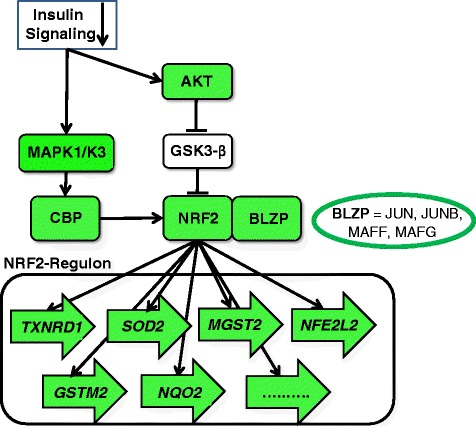Fig. 5.

BMI-associated down-regulation of the NRF2 regulon. The transcription factor NRF2, after translocation from the cytoplasm to the nucleus, binds to the cis-acting enhancer sequence ARE (Antioxidant Response Element) located in promoters upstream of several genes encoding proteins necessary for glutathione synthesis and electrophile detoxification (for details see Additional file 1: Supplementary Materials S3). Transcriptional activation of ARE-mediated genes requires hetero-dimerization of NRF2 with other basic leucine zipper proteins (BLZP), namely JUN (c-JUN, JUN-D and JUN-B) and the small musculoaponeurotic fibrosarcoma (MAF) proteins (MAFG, MAFK and MAFF). In addition, the CREBBP encoded CBP protein [cAMP-response element binding protein (CREB) binding protein], a histone acetyl transferase, represents a nuclear co-activator directly trans-activating NRF2. Among the prominent ARE-mediated NRF2 targets genes are GSTM2 and MGST2 encoding the glutathione S-transferases μ2 and microsomal glutathione S-transferase 2, respectively, the NQO2-encoded NAD(P)H:quinone acceptor oxidoreductase 2, the SOD2-encoded manganese-containing superoxide dismutase 2 (MnSOD), and the TXNRD1-encoded thioredoxin reductase 1. In addition, the NRF2 encoding gene NFE2L2 contains two ARE-like sequences in its promoter and is therefore auto-regulated by NRF2 in a positive feedback-loop. Green coloring indicates that the corresponding mRNA abundances were negatively correlated with BMI in the present study. Arrows indicate ARE-regulated genes
